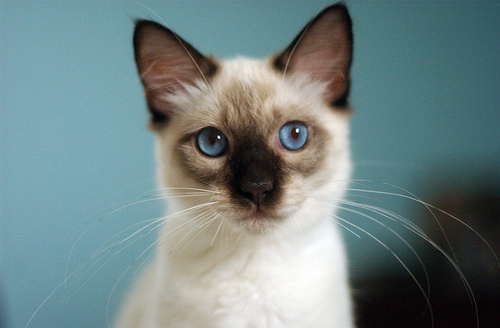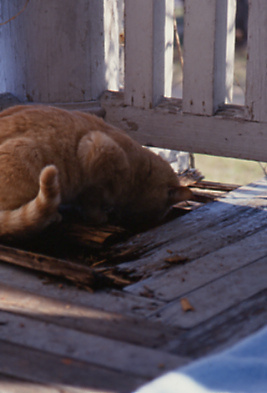Amy Shojai's Blog, page 118
April 17, 2013
Pudgy Pooches & Tubby Tabbies

Chasing a new puppy around is a GREAT diet aid!
A couple of my friends look terrific after they’ve recently lost weight. I found it. *sigh*
It’s not that I don’t know how to eat right, I do. It just takes more thought and planning, and I’ve let a lot of that slide as I tried to meet deadlines. It’s a whole lot easier to stay on top of the pet’s nutrition and waistline than my own.
Is your pooch pudgy or fat? Obesity is defined as exceeding ideal body weight by 20 percent, and today about forty percent of pets are considered overweight. If you can’t feel the pet’s ribs, and/or she has a pendulous or bulging tummy, your pet is too plump. Obesity increases risk for diabetes, and is an aggravating factor in heart problems, arthritis, and skin problems. Puppies are cute when chubby but that puts them at risk as well. I’ve just written two new articles on the subject of fat puppies here.
I’m very fortunate that Magic has always been super athletic. Heck, he’s in MY diet plan, and ensures that I get up out of the computer chair and move several times a day, just to be sure he gets his exercise. Seren also has always been petite and active, and still weighs only slightly over six pounds. I suspect that’s why she’s still able to run rings around the dog, despite her age (16) and arthritis. But if you have an overweight pet, here are some tips for helping to slim down tubby tabbies and pudgy pooches. Heck, I’m using some of these tips on myself!
How to Slim Your Pet
Curb Snacks. Eliminating or reducing treats easily cuts calories. Instead, reserve part of the pet’s regular diet—a handful of kibble, for instance. Keep it handy to dispense as “treats” when your dog pesters, or reward with attention, not treats. In my case, I’ve got some fresh cut veggies prepared ahead. Now, if celery came with chocolate chips, I’d be happier.
Meal Feed. Rather than keeping the bowl full for all day nibbling, switch to meal feeding measured amounts. Divide the daily food allotment into four or even five small meals keep her from feeling deprived. Multiple small meals increase the body’s metabolic rate, so she burns more calories faster. (Hey, this works for me, too, when I can manage to do it.)
Offer Diet Foods. Reducing diets typically replace fat in the food with indigestible fiber, dilute calories with water, or “puff up” the product with air. “Senior” diets typically have fewer calories, so switching older pets to an age-appropriate formula helps. “Lite” diets aren’t magical and only mean the food has less calories than the same brand’s “regular” food—it might have more calories than another company’s food. Some pets eat more of the diet food to make up for lost calories, so you still have to measure the meals. Be sure to check with your vet before deciding to make major nutrition changes, though. Cats don’t do “crash diets” well and can get very sick with a liver condition (hepatic lipidosis) that can kill.
Go For A Walk. Make twice-daily 20 minute exercise part of your routine. Cats won’t power walk, but a slow to moderate stroll at the end of the leash once or twice a day around the house or garden will help burn energy. Magic and I have our 20+ minute ramble each morning, and then two or three more 10-minute fetch-sessions throughout the rest of the day.
Create A Treasure Hunt. Put food at the top or bottom of the staircase, or on a cat tree so kitty has to get off her pudgy nether regions to eat. If she can’t manage stairs or leaps, put the bowl on a chair and provide a ramp up so he’s burning a few calories. Setting the bowl across the house from the dog or cat’s bed also forces them to move. Use commercial treat balls, puzzle toys like Kongs or interactive feeders and place meals inside so the pet has to work to get out the food. For pets that eat canned foods, there are also refrigerated feeders or insulated bowls that help keep it fresh.
How do you handle your pudgy pet? Does he or she eat a special diet, or do you try to increase exercise in some way? What tricks work for your clowder, please share! Obesity impacts more than looks. It’s also a longevity issue. Slim dogs and cats live up to two years longer than overweight pets.
I wonder if they make “puzzle toy feeders” for humans?
Your email:
I love hearing from you, so please share comments and questions. Do you have an ASK AMY question you’d like answered–post in the comments or dial me up each Monday night on the new weekly CAT CRAZY radio show. Do you have a new kitten and need answers? Stay up to date on all the latest just subscribe the blog, “like” me on Facebook, check out weekly FREE PUPPY CARE newsletter, and sign up for Pet Peeves newsletter. Stay up to date with the latest book give aways and appearances related to my THRILLERS WITH BITE!
April 15, 2013
Monday Mentions: Deadlines & Lifelines
I have good news, and not so good news, and great news to share. First, I’m finally making significant progress on HIDE AND SEEK (the sequel to my 65+ starred review thriller LOST AND FOUND). I have a deadline looming every closer and have been scrambling to find a floaty-device to keep me from drowning in my to-do lists.
The bad news–in order to get traction on the fictioning process, I’ve had to make some very difficult decisions and slooooooow down on other fronts. Sadly, I’ve had to step away from some of my favorite projects, including the CAT CRAZY radio show. I’ll still be a “special friend” of the show and hope to return to the co-host chair once I’ve survived the various deadlines. Thanks so much for continuing to support the show.
Oh, the great news? MY LAPTOP IS HOME! Talk about a lifeline, that is very good news that I really needed. As far as I can tell (thus far) it’s made a full recovery thanks to the awesome Geek Squad over at Best Buy. That means I’ll be able to finish the audio version soon of the ComPETability (Dogs-to-Dogs) book and future titles. On that front, I again encourage y’all to subscribe (if you haven’t already) to my PET PEEVES newsletter. There’ll be some extreee-spashun book news on Thursday that will be announced there first. 
Monday Mentions is the mash-up-day of all the neato-torpedo writer links and videos, pet schtuff and bling and writer-icity crappiocca collected over the past week. Check out the SQUEEE! cute pet-astic videos at the bottom, too. For new followers to the blog, welcome! and you can expect more cat and dog specific schtuff later in the week on Wednesday and Friday.
WRITER-ICITY SCHTUFF
Cat Writers Association Early-Bird Conference Registration!
Google Alerts Goes Away–Enter Talkwalker Alerts I’ve signed up, we’ll see how well it works. Another one is Web Mention. Thanks to Leona DeRosa Bodie for the links.
B&N Launch Nook Press too little too late? Hmnnn. Check it it out here. And here’s more on what this writer calls an “insanely bad contract”
Screenplay Competition for Sci-Fi, Horror, Fantasy
5 Tips for Self-Pub’d Authors on Rights Issues
Writing in Sickness & Health a great post on fueling your fever (and other stuff) from August McLaughlin
5 Questions to Ask Characters Before you Write
Top 10 Book Blogs 2013 from Story Cartel a list you’ll want to bookmark!
Google+ Building Author Platforms a great post and tips from Marcy Kennedy–hint, she’s giving a 90-minute webinar April 20 with more info!
Les Edgerton Dialogue Tips Part 3
Cautions for ACX-AUDIBLE Authors oh dear…now what?
Slow Death of The American Author do you agree? David Gaughran’s response puts a whole other spin on things with What Scott Turow Doesn’t Care About
Did you read Stephen King’s “Under The Dome” — it’s coming to TV and I can’t wait! See the trainer/interview with Mr King, below.
PET-CENTRIC SCHTUFF
RECALL! Virbac Heartworm Preventive for Dogs
Internet Vet Advice Shut Down! Oh wow…lots of websites could be in trouble if this stands, what do you think?
Cats Rule the ‘Net…but Dogs Rule Print oh yeah? what do you think?
Natural Remedies to Cat Allergies from two of my fav sources, Sally Bahner guest posting on The Conscious Cat blog!
Thank you to KB Owen for the head’s up about this great video!
I love hearing from you, so please share comments and questions. Do you have an ASK AMY question you’d like answered? Do you have a new kitten and need answers? Stay up to date on all the latest just subscribe the blog, “like” me on Facebook, listen to the weekly radio show, check out weekly FREE PUPPY CARE newsletter, and sign up for Pet Peeves newsletter. Stay up to date with the latest book give aways and appearances related to my THRILLERS WITH BITE!
April 12, 2013
Cat Whiskers

Maybe kitty will grow into them…Image Copr. Diane G. Zooms/Flickr
I’m fascinated by kitty whiskers, how about you? Does your cat have lots of whiskers, or only a few? Have you noticed how s/he actually uses them? Seren has a “wild” whisker that’s started to grow curled forward now that she’s an aging kitteh. And for some of the longer furred cats, you might not even see all of the whiskers.
THRILLERS WITH BITE!
April 10, 2013
Lick Maniacs & Canine Chewers
 Has your dog ever lick-lick-licked himself raw? I have to watch Magic because he has a tendency to lick his paws or legs quite a bit, especially in the evenings when winding down for the night. My first shepherd developed ulcers on his paws and between the toes he continually licked. His were a consequence of severe atopic allergy, so I’m pretty sensitive to the tendency and interrupt the behavior.
Has your dog ever lick-lick-licked himself raw? I have to watch Magic because he has a tendency to lick his paws or legs quite a bit, especially in the evenings when winding down for the night. My first shepherd developed ulcers on his paws and between the toes he continually licked. His were a consequence of severe atopic allergy, so I’m pretty sensitive to the tendency and interrupt the behavior.
LICK GRANULOMAS
Lick sores, technically termed lick granulomas, are pretty common and can develop from any minor injury from bug bite to a thorn. They can continue due to canine boredom. The affected dog incessantly licks a selected area, usually on a lower leg, which creates a raised, hairless ulcerative plaque — almost a callus that surrounds the never-healing sore. The constant licking makes the area itch and can cause secondary bacterial infection. This prompts further licking to relieve the itch, and a vicious cycle is created.
Any dog can be affected, but the condition most commonly affects older dogs. The syndrome is often seen in large active-breed dogs that demand a lot of owner interaction, such as Golden Retrievers, Labrador Retrievers, Doberman Pinchers, Great Danes, and–YEP–German Shepherd Dogs.
Diagnosis is based on the clinical signs, history, and microscopic examination of the lesion (biopsy). Treatment is difficult, and some dogs may never be completely cured. Infections may respond to antibiotics, and steroid injections may temporarily soothe itchiness.
There are some pain reliever/anti-inflammatory ointments that can help break the itch/lick cycle. Some newer “liquid bandage” materials may help. When the behavior stems from boredom, the best treatment is to give the dog something better to do with his time. Here are some tips for relieving doggy boredom.
The habit may be interrupted in some dogs through the use of veterinary prescribed drugs. Behavior drugs used in treating obsessive/compulsive disorders may be effective in certain instances.
Do your dogs lick or chew excessively? How do you manage the behavior? What successful treatment has your veterinarian prescribe? Please share!
This is a topic I’m covering in the future release of my updated PURINA ENCYCLOPEDIA OF DOG CARE. I’d LOVE to have your discussion/opinions for possible inclusion so fire away in the comments!
Your email:
I love hearing from you, so please share comments and questions. Do you have an ASK AMY question you’d like answered–post in the comments or dial me up each Monday night on the new weekly CAT CRAZY radio show. Do you have a new kitten and need answers? Stay up to date on all the latest just subscribe the blog, “like” me on Facebook, check out weekly FREE PUPPY CARE newsletter, and sign up for Pet Peeves newsletter. Stay up to date with the latest book give aways and appearances related to my THRILLERS WITH BITE!
April 8, 2013
Monday Mentions: Thrillers, Hedgehogs & Bats
Our roses have just begun to bloom–no, that picture was from last year. There’s another month to go before peak blossom time but I can’t wait. This year promises to be a glorious blooming frenzy (do blossoms frenzy?). As of last Friday the laptop gurus said my computer was FIXED and being shipped home so by the time you read this, I hope to have the laptop back. That means I can sit outside on the patio, amidst all the bloom-icity, while continuing the draft of the next thriller. Yeee-haw!
I want to encourage y’all to subscribe (if you haven’t already) to my PET PEEVES newsletter. There’ll be some extreee-spashun news in the middle of April and it will be announced there first. 
Remember that tonight (and EVERY Monday night!) you can listen and call in with your pet questions on my new CAT CRAZY radio show. 
Monday Mentions is the mash-up-day of all the neato-torpedo writer links and videos, pet schtuff and bling and writer-icity crappiocca collected over the past week. Check out the SQUEEE! cute pet-astic videos at the bottom, too. For new followers to the blog, welcome! and you can expect more cat and dog specific schtuff later in the week on Wednesday and Friday.
WRITER-ICITY SCHTUFF
The REAL Story of Indie Publishing, you do not want to miss this!
Kick-Starter How To, Part 4 (check out previous installments Part 1, Part 2, Part 3)
E-Books for Bloggers Yep, that’s what I’ll speak about at the May BlogPaws . . . but it’s not just for bloggers, of course!
WordPress.ORG vs WordPress.COM the good, the better, the best
How to Write A Bestseller–then Quit a fascinating post by Colin Falconer
Amazon Kindle-book Return Policy–BOO-HISSSS!
Re-selling Digital Goods not so fast!
Lyrics In Your Novel? Do it Right (Legally!)
Global E-Book Awards from my colleague Dan Poynter (he has an awesome email newsletter, too!)
Les Edgerton Dialogue Primer good stuff! And here’s Part 2.
Common Jargon Writers Should Avoid I most certainly aspire to thinking this article has the capability to facilitate your utilization of word-smithery mechanics. Ahem. Shared from my colleague Andrea Dorn
5 Quick Facebook Tips for Busy & Shy Peeps from a great blogger Gene Lempp

National Service Dog Eye Exams registration now open!
PET-CENTRIC SCHTUFF
National Service Dog Eye Exams registration now open! A way to keep service dogs healthy–American College of Veterinary Ophthamologists partner with Merial to provide service dogs and horses with eye care. Learn how to participate by clicking the link (or the picture).
Petfinder’s I AM A CAT PARENT Campaign get the scoop at the awesome Conscious Cat Blog
Skin Diving Goes to the Dogs…and Also the Cats (I don’t think Seren would approve)
New Cat Intros from my friend, cat behavior expert Marily Krieger
R.O.A.R. for the Animals a neat Rescue Operation for Animals Of the Reservation
Jackson Galaxy “My Cat From Hell” Show Returns, interview by my friend Sally Bahner
I love hearing from you, so please share comments and questions. Do you have an ASK AMY question you’d like answered? Do you have a new kitten and need answers? Stay up to date on all the latest just subscribe the blog, “like” me on Facebook, listen to the weekly radio show, check out weekly FREE PUPPY CARE newsletter, and sign up for Pet Peeves newsletter. Stay up to date with the latest book give aways and appearances related to my THRILLERS WITH BITE!
April 5, 2013
How Cats Hunt

“Come to momma…”
Is your kitty a “mighty hunter?” How does your cat hunt and what kind of big game does s/he capture? I’ve written about gift-bearing cats before to explain the whole idea behind why Sheba leaves mousy offerings just for you, URK!
But I wonder how proficient cats might actually be. In the past weeks, there have been a number of hand-waving outrageous claims of outside cats decimating bird populations, and those figures tend to be based on guestimates of populations and extrapolations of X-number-bird-meals per cat.
I dunno. Seren may have the equipment and heritage to hunt, but her finely honed hunting expertise begins with the bowl and ends with (at a stretch) crickets. Oh, but she leaves the buggy drumsticks behind (must not have enough meat on ‘em). I have a friend with a cat and Shadow hunts and stalks…(wait for it…) DUST RAGS. Nom-nom-nommy-good.
Anyway, just as with anything else, the ability to hunt requires skill and technique that can only be learned–and earned–through practice. Kittens hone technical skills through play with their littermates, and by their mother’s example but if they’re indoor only cats, they may never get the chance to face off against a ferocious sparrow. The outdoor kitties that do have to feed themselves generally have a low success rate due to poor nutrition or just because the odds are against them. They have much great success with ground-dwelling critters like mice, voles, and lizards since healthy adult birds can stay out of reach.
HOW CATS HUNT
Cats don’t need to be hungry to hunt. It’s the sound and sight of moving prey that provides the stimulus to chase and capture, a hardwired behavior as natural to the cat as purring. That’s one reason kitten play aggression that grapples your moving ankles can prove so energetic and intense.
Feline hunting behavior relies heavily on sight and hearing to locate prey. Cats use a couple of hunting strategies, depending on the prey they seek. Sometimes Kitty prefers ambush, and will crouch in a likely spot — perhaps with eyes glued to the mouse hole — and wait with infinite patience for prey to appear. Cats may return time after time to areas where their hunts have been successful.
Fishing requires patience, too. Typically the cat waits in a likely spot on the bank for a suitable candidate to appear, then uses a paw to scoop and flip the fish from the water. In shallow water, Kitty may wade in and use both paws by pouncing and grasping the fish. Not all cats are able to perfect fishing technique, probably because of the visual perception difficulty regarding the water. But even dry-land-dwelling kitties use the fish-scoop technique down a likely hole that may yield something yummy.
The stalk-and-pounce method has many components. Once the prey is located, the cat quickly moves closer in a low to the ground pose, and then stops and freezes sometimes for endless moments while watching the prey. If the target moves farther away, the cat adjusts by ever-so-slowly creeping forward one paw-step at a time, even freezing with a foot in mid-air to avoid revealing herself. For the final rush, she gathers rear legs beneath her and treads in preparation for for a forward thrusting take-off. It may require several darting leaps before she’s near enough for the final pounce.
HOW CATS KILL
Rarely is the quarry dispatched right away. Often, it escapes and Kitty must attempt to chase it down for recapture. Cats often indulge in a great deal of pouncing and tossing of prey into the air, allowing escape only to recapture small game. This isn’t inherent cruelty and serves a couple of purposes. “Playing” with the prey is a way for the cat to practice her skills, and also tests just how dangerous that rat or snake might be. Properly socialized felines have learned to inhibit their bite through play with owners and other cats, and toying with the quarry helps them build up the necessary excitement for the coup-de-grace.
Cats kill by biting the neck where the skull joins the spine, severing the vertebrae with the dagger-like canine teeth. They grasp the neck and use a “chattering” movement to position their bite accurately. In fact, cats frustrated in the hunt (i.e., watching from a window as squirrels play outside) often exhibit this chattering behavior which is actually the killing bite, in reaction to seeing out-of-reach prey.
Once the prize is dead and stops moving, the cat typically seems to lose interest for a short time. After the thrill of the hunt, the chase, and the kill, the cat needs time to return to an emotional equilibrium, and she may groom herself before claiming the prize. Then, she’ll carry the prey to a well-sheltered area to eat. Like your pillow.
This is a topic I’m covering in the future release of my updated PURINA ENCYCLOPEDIA OF CAT CARE. I’d LOVE to have your discussion/opinions for possible inclusion so fire away in the comments!
Your email:
I love hearing from you, so please share comments and questions. Do you have an ASK AMY question you’d like answered–post in the comments or dial me up each Monday night on the new weekly CAT CRAZY radio show. Do you have a new kitten and need answers? Stay up to date on all the latest just subscribe the blog, “like” me on Facebook, check out weekly FREE PUPPY CARE newsletter, and sign up for Pet Peeves newsletter. Stay up to date with the latest book give aways and appearances related to my THRILLERS WITH BITE!
April 3, 2013
What Dogs Taste

“Nom-nom-nom-nom-nom….” Image Copr. Barry Fryer
What dogs taste is a topic I’m covering in the future release of my updated PURINA ENCYCLOPEDIA OF DOG CARE. I’d LOVE to have your discussion/opinions for possible inclusion so fire away in the comments! Of course, we know some of the odd and nasty weird stuff dogs eat–I really do need to record an Ask Amy about why dogs drink out of the toilet–but do they actually taste such things?
WHAT DOGS TASTE
The taste system of dogs is used as a model for people because they are so similar but it appears young dogs don’t care as much about taste in relation to food preferences, and rely more on smell. This past year I attended lectures at a couple of pet food companies that included information about pet smell preferences–some are quite surprising! What are some unusual scents that your dogs seem to enjoy? With Magic, dirty socks might be a flavor enhancer . . .
Not everything is known about the dog’s sense of taste. We know that a facial nerve is “wired” to the taste buds on the front two-thirds of the tongue only, leaving the remainder somewhat of a mystery. Most of the dog’s taste buds are circular structures located on the upper forward surface of the tongue, and in four to six large cup-shaped bumpy papillae at the rear of the tongue.
CANINE SWEET TOOTH & MORE
The majority of canine taste buds respond to sugar, which can get them in trouble when they indulge in eating toxic but sweet antifreeze or chocolate. This is most likely a reflection of their omnivorous evolution. Dogs needed to eat seasonal fruits and vegetables to survive, so they evolved a sweet tooth because sweetness is a mechanism in plants that signals optimum ripeness. And like people, dogs are able to detect a kind of “fruity-sweet” flavor that attracts us — and them — to the calorie-rich ripeness of fruits and vegetables.
The second greatest number of canine taste buds respond to acidic tastes, which correspond to sour and bitter in people. However, dogs don’t appear to have a specific response to salt. Odors coupled with taste tend to impact what the dog will eat.
BEYOND DOGGY TASTE BUDS
Interestingly, the dog’s taste receptors don’t stop in the mouth, but extend down into the larynx. Dogs can taste and seem to prefer a “sweet” taste, from both carbohydrates and meaty sources and salty flavors. Sour perception and bitter tastes are more sensitive to aging changes. Many dogs have only a quarter of the active taste buds as when younger.
Chemical irritations and “mouth feel” influence how well the dog likes or dislikes a flavor, too. That explains some of the odd kibble shapes that commercial food companies create. Taste also is influenced by changes in saliva production so for aging dogs with dehydration problems, this may impact the dog’s sudden “snubbing the food” that he adored before. Even the odors or tastes produced by dental disease can make a dog refuse a favorite food.
What about your dogs? Are they garbage gluttons that snarf without sniffing first? Or do they need a whiff before ready to gulp?
Your email:
I love hearing from you, so please share comments and questions. Do you have an ASK AMY question you’d like answered–post in the comments or dial me up each Monday night on the new weekly CAT CRAZY radio show. Do you have a new kitten and need answers? Stay up to date on all the latest just subscribe the blog, “like” me on Facebook, check out weekly FREE PUPPY CARE newsletter, and sign up for Pet Peeves newsletter. Stay up to date with the latest book give aways and appearances related to my THRILLERS WITH BITE!
April 1, 2013
Monday Mentions: Book Giveaway, Laptop Looser & April Fools Fun

Cat ears that move with your mood! (check out the matching tail, too!)
Seren is starting off the week right with some catnip, I’m getting caffeinated, and it’s the first day of a new month–fresh start, right? By now the laptop travails should be resolved. The replacement mother-luvin’ board arrived, the techno-miracle workers at Best Buy installed it, they called to say it worked great (YEE-HAW!) but did I want them to run full diagnostics while it was there? Feeling generous and relieved, I said, “You betcha!” And yep, my virtual tail was a-wagging. (I may need those ears, too!)
And two days later, the mother-lovin-board (new one) gave up the ghost. Gak! So now it’s been sent on to the Best Buy uber-wiz-bang folks. And I’ll be shopping for a new just-in-case laptop so I’ll have a backup in future. Oh, and before there’s a re-run of all the well-intended urgings to MAC-ATTACK, I’ll pass and here’s why. I already have two working desktops, music writing software, photoshop, audio-recording software and more running on existing machines and I need ‘em all to “play nice.” I have no time/energy for yet another learning curve with my deadlines. So while I’m sure the MAC would be a magic wand cure for all-that-ails-the-tech-world, I just can’t afford the time/$$ investment.
 I’m excited to announce that my Cat ComPETability book is now available in PRINT! And to celebrate, you can enter for a give-away for a paw-tographed copy of the book. Meanwhile, I’ve once again crossed off major must-do’s so that this month will be one devoted to fictioning. Remember that tonight (and EVERY Monday night!) you can listen and call in with your pet questions on my new CAT CRAZY radio show.
I’m excited to announce that my Cat ComPETability book is now available in PRINT! And to celebrate, you can enter for a give-away for a paw-tographed copy of the book. Meanwhile, I’ve once again crossed off major must-do’s so that this month will be one devoted to fictioning. Remember that tonight (and EVERY Monday night!) you can listen and call in with your pet questions on my new CAT CRAZY radio show. 
Monday Mentions is the mash-up-day of all the neato-torpedo writer links and videos, pet schtuff and bling and writer-icity crappiocca collected over the past week. Lots of fun pet-astic videos at the bottom, too. For new followers to the blog, welcome! and you can expect more cat and dog specific schtuff later in the week on Wednesday and Friday. In honor of APRIL FOOL’S DAY, one of the topics below is less than truthful–can you guess? The answer is clear at the bottom (don’t cheat!).
WRITER-ICITY SCHCTUFF
Goodreads Acquired by Amazon from the Goodreads founder. And here’s more from Amazon. Tim Spaulding from LibraryThing weighs in, and why this is GOOD thing from discussion from David Gaughran.
Agent-Assisted Publishing & Amazon White Glove from the awesome Melissa Foster
Website Hosting–Info You Need to Know from Jami Gold
Congrats to the Thriller Award Nominees!
PET-CENTRIC SCHTUFF
Were you right? Here’s the scoop on what’s bogus and why!
I love hearing from you, so please share comments and questions. Do you have an ASK AMY question you’d like answered? Do you have a new kitten and need answers? Stay up to date on all the latest just subscribe the blog, “like” me on Facebook, listen to the weekly radio show, check out weekly FREE PUPPY CARE newsletter, and sign up for Pet Peeves newsletter. Stay up to date with the latest book give aways and appearances related to my THRILLERS WITH
March 29, 2013
Easter Bunny-licious? Make Mine Chocolate!

Bunnies need love and proper care–they are not an impulse! Photo from House Rabbit Society
“Here comes Peter Cottontail, hopping down the bunny trail…” Easter’s on its way, and rabbits go hand-in-paw with this annual holiday. But stop and think carefully before adopting one of these doe-eyed beauties. Rabbits require special care and you may get more than you bargained for.
Bunnies are intelligent, social animals who need affection and get along well with cats and well-behaved dogs. They can be litter box trained (emphasis on the trained)–it doesn’t happen with the wave of a wand. Rabbits tend to eat and poop at the same time–the original multitasking pet–so standard clay cat litters won’t work and can be dangerous to bunnies. You’ll find tips on rabbit care and training at the House Rabbit Society, a nonprofit group dedicated to helping educate the public.
BUNNY MARKING
Similarly to cats and dogs, intact rabbits use bodily functions to mark territory. You’ll need to spay or neuter your bunny friend to curtail the hormones that prompt marking behavior. This also decreases destructive chewing and territorial aggression. An attack rabbit is no laughing matter! House rabbits should be “fixed” between the ages of 3-1/2 to six months, depending on sexual maturity, by an experienced rabbit veterinarian.
A GNAWING HABIT
Once de-sexed and litter box trained, bunnies can freely roam your home and interact with the whole family. But first, rabbit proof the house. It’s natural for rabbits to chew on just about anything: furniture, rugs, drapes, and even deadly electrical cords.
Use the same tips for preventing canine teething to safeguard rabbits and provide safe chewable alternatives and toys to keep the bunny happy and distracted. Rabbit experts recommend cut, dried branches from apple, willow or aspen, or pine firewood; cotton towels; baskets or cardboard boxes filled with hay; and compressed alfalfa cubes. Juvenile delinquent bunnies under a year of age are more mischievous, and require more safe confinement and bunny proofing than older rabbits.
PROPER BUNNY CARE
Your pet bunny requires the same good veterinary care you provide for your cats and dogs, and rabbits are prone to specific health issues you’ll need to address. For instance, bunnies are naturally clean and groom themselves constantly–but that makes them prone to fur balls like Kitty. But rabbits can’t vomit. If the excess fur can’t be passed into the litter box, a blockage can kill the pet. Therefore, you’ll need to regularly groom your rabbit, provide at least 30 hours exercise a week to keep bunny moving on both the outside and inside, and provide fresh vegetables to help keep her regular. Special bunny hairball laxatives can help during molting season.
This year prepare ahead of time for your new Easter bunny surprise. You know your situation best. Bunnies can be rewarding pets but they do require time, training, and appropriate care. In the months following Easter, local humane societies and rabbit rescues are flooded with rabbits, former Easter gifts whose owners no longer want them. The unlucky ones are dumped outside where they usually become victims of predators, cars, illness, and injury.
Easter is a joyous time of rebirth and hope. Enjoy the egg hunts, the candy bowls, dinners with family and friends–and if you’re ready, welcome a living creature into your home and heart. If not ready for the breathing/chewing/pooping version, celebrate the wonderful world of bunnies with a stuffed toy, or a chocolate rabbit. They won’t mind being tossed aside.
Do you share your home with a bunny? My brother’s family has a pet rabbit that gets along well with the cats and dog–it can be done! Please share your bunny-licious experiences.
Your email:
I love hearing from you, so please share comments and questions. Do you have an ASK AMY question you’d like answered? Do you have a new kitten and need answers? Stay up to date on all the latest just subscribe the blog, “like” me on Facebook, listen to the weekly radio show, check out weekly FREE PUPPY CARE newsletter, and sign up for Pet Peeves newsletter. Stay up to date with the latest book give aways and appearances related to my THRILLERS WITH BITE!
March 27, 2013
Easter Candy Caution for Pets

Puppy pens keep baby out of trouble!
Image Copr. D.Garding/Flicker
Easter season comes early this year. And although we love those chocolate eggs and candy bunnies overflowing the kid’s Easter baskets, a chocolate indulgence for pets can turn celebration into calamity.
Cats aren’t poisoned as often because they are a bit more discriminating about what they munch. But dogs often smell the candy right through the packaging, and eat it wrapper and all. Swallowed objects like foil or paper wrappers or the sticks off of suckers can cause intestinal blockage or damage, too.
CHOCOLATE TOXICITY
Any candy indulgence can pose digestive upset with messy results and a need for you to invest in a carpet cleaning service for the stains. But chocolate toxicity can actually kill your pet. Chocolate contains theobromine, a stimulant related to caffeine. Eating too much chocolate shifts your pet’s heart into overdrive.
Milk chocolate usually doesn’t cause life-threatening problems because it takes nearly two pounds of milk chocolate to poison a seven-pound pet. Baker’s chocolate can be deadly, though. It contains ten times as much theobromine as milk chocolate, which means a seven-pound pet only needs to eat two ounces to be poisoned. Licking chocolate frosting, lapping up cocoa mix, or gulping truffles—a very rich dark chocolate treat—causes vomiting, diarrhea, hyperactivity, seizures, coma, and even death.
MAKE HIM VOMIT!
If you catch your pet snacking on such things, induce vomiting as soon as you can to get rid of the poison. You can make her vomit up to an hour after she’s eaten the chocolate, but sooner is better. After an hour, the toxin has probably moved out of her stomach into the intestines, and vomiting won’t get rid of it.
It can be dangerous to induce vomiting if the dog or cat acts woozy. They can inhale the material on its way up and suffocate. As long as she’s alert, there are several methods you can use to get rid of the chocolate. Call the veterinarian for further instructions after the pet has emptied her stomach. If you can’t induce vomiting after a couple of tries, prompt veterinary care is even more important.
Better yet, don’t bring dangerous treats into your house. Here’s a thought—you could give the extra chocolate to me. I’m willing to make the sacrifice and dispose of the deadly sweet treats to protect your pets.
Your email:
I love hearing from you, so please share comments and questions. Do you have an ASK AMY question you’d like answered? Do you have a new kitten and need answers? Stay up to date on all the latest just subscribe the blog, “like” me on Facebook, listen to the weekly radio show, check out weekly FREE PUPPY CARE newsletter, and sign up for Pet Peeves newsletter. Stay up to date with the latest book give aways and appearances related to my THRILLERS WITH BITE!





